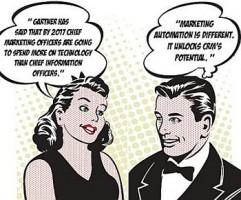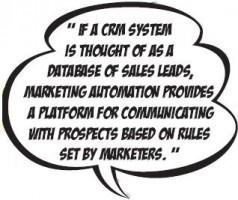Published on the 19/09/2013 | Written by Anthony Doesburg

As the lines between marketing, sales and service blur ‘smarketing’ is the way forward. Anthony Doesburg investigates this blend of sales and marketing and asks if the tools are delivering on their promise, or are they just more marketing puffery?…
In a marketing world in which tools and tricks of the trade typically have a brief shelf life, it would be no surprise to find Google Glass had already been adapted to help businesses sell more stuff. That’s certainly the way it appeared on 1 April on the website of marketing software company HubSpot. Anyone landing on hubspot.com was exhorted to open their eyes to a revolutionary new tool with more than a passing resemblance to Google’s high-tech spectacles. Video featuring HubSpot’s marketing and product development chiefs revealed SprocketVision, a gadget whose wearers were apparently able to identify sales prospects by a virtual sprocket — HubSpot’s logo — hovering above them. Based on real-time analysis of the interaction with the prospect, SprocketVision then prompted the wearer with a winning sales pitch. As April Fools’ jokes go, it was a slick stunt. And as it turns out, the video is just one of hundreds of online HubSpot promotional clips, many of them playing off YouTube phenomena such the Harlem Shake and Gangnam Style dance crazes. Six-year-old HubSpot, based in Boston, is a prime example of a company that eats its own dog food. As founder and chief executive Brian Halligan says in yet another video, the company was set up to rewrite the classic marketing playbook that consists of buying a list of prospective customers, doing endless emailing and cold calling, advertising and going to trade shows. Although – or perhaps because – it was widely used, the classic model was broken, Halligan concluded; namely, people were sick of being marketed at. His answer: show companies how to turn the marketing flow around using techniques such as HubSpot’s attention-getting videos. No more menial marketing At a basic level, that means automatic segmenting of data lists so marketers can better target prospects, and providing ready analysis of campaign results. As social media proliferate, marketing automation also gives marketers the tools to manage the various channels by which they communicate with prospects. Marketing automation is not to be confused with customer relationship management (CRM). If a CRM system is thought of as a database of sales leads, marketing automation provides a platform for communicating with prospects based on rules set by marketers. Except in HubSpot’s case, Halligan says: instead of mass communication driven by the marketer, HubSpot’s inbound marketing model gives the customer the information he or she seeks through data-driven, personalised communication. Inbound marketing delivers leads at less than half the cost of outbound marketing, he contends. HubSpot is racking up customers, with nearly 8500 in 46 countries — including Australia and New Zealand. According to Halligan, more than 90 percent of them had increased website traffic and leads within a year of using the software.“HubSpot has been developed to make it easy for customers to practise effective, personalised marketing,” Halligan says, trotting out the company mantra that “1+1=3”, where content and context go hand-in-hand. Although mostly separate (not, however, in the case of InfusionSoft), CRM and marketing automation systems work in tandem. HubSpot uses Salesforce.com, as do Marketo and Oracle-owned Eloqua, to create a closed-loop ‘smarketing’ tool that aligns sales and marketing. The relationship between the two makes it easy for marketers to “convert, close and delight” customers, Halligan says, by showing them which of their marketing efforts work and for whom. Salesforce.com, meantime, is not confining itself to CRM. It can justifiably claim to have led CRM into the cloud and is continuing its pioneering ways with cloud-based tools for companies to connect to customers via social media and mobile devices. Salesforce.com’s Marketing Cloud “seamlessly” connects marketing with sales and service, the company says. “Marketing is undergoing its biggest shift in decades, as brands move from traditional strategies to connecting with customers and fans globally through social media. “Gartner has said that by 2017 chief marketing officers are going to spend more on technology than chief information officers. The Marketing Cloud empowers brands to take advantage of this shift, turning insight into action and connections into customers for life.”“As the lines between marketing, sales and service blur, we’re seeing that the CMO is a strategic and critical part of how every company operates,” says Sydney-based public relations manager Katie Dufficy. HubSpot’s Halligan also sees social media as an increasingly important piece of the puzzle in attracting new customers. HubSpot’s experience is that two thirds of business-to-consumer and between a third and a half of business-to-business companies that use Facebook for marketing have gained customers through that channel. Functionality that alerts users to the best times of day to make social media postings and gives them one-click analysis of social campaigns are therefore important features of marketing automation systems. Join the sales and tech loops Warren Everitt, the Melbourne-based managing director of Eloqua partner MarketOne, says the systems’ early adopters were big B2B outfits. “The large technology companies pioneered using automated processes for end-to-end lead lifecycle management in the mid-2000s,” says Everitt, naming Intel and Google as examples. With marketing budgets to match their size, they could afford the $100,000 – $200,000 annual cost of implementing the systems. “Sales and marketing automation doesn’t come cheap. If you really want to do things properly and get more than just an email marketing platform you need an end-to-end process that includes lots of mediums and messages to communicate with and touch customers. “Many of the companies we work with in the B2B technology space have money to spend to implement that process and the success they’ve had has driven the buzz around these systems.” Everitt says the marketing automation trend began in the United States, spread to the UK, where he worked for four years, and is now being seen in the Asia-Pacific region. “I remember in 2005, when there were one or two marketing automation platforms available, if you talked to people about them they had no idea what you were on about. But by the end of 2007 everyone in the UK wanted one.” Everitt says word has filtered down to the APAC branch offices of companies with northern hemisphere headquarters where marketing automation has been a hit. “Everyone now seems to know a bit about it and we’re seeing a real increase in people wanting to adopt it.” “Then you need to implement it. You need to have nurturing programmes in place, you need to have content, you need to have all of the associated elements of an end-to-end lifecycle management process and plugging all of that in is quite costly.” For companies with six-figure marketing budgets, the expense is no obstacle, Everitt says. “The B2B technology companies we work with have those sorts of budgets and it’s not a big deal because we’re able to prove the return on the marketing investment is there.” If there is a single ingredient for success across the range of organisations MarketOne works with, Everitt says, it is ensuring the customer’s marketing and sales functions work together. “The biggest challenge in most businesses is that marketing is seen as one department and sales is another and they don’t communicate. One of our KPIs is around how aligned marketing is with sales after we’ve implemented a marketing automation campaign. “Are the marketing messages or the trigger points pushing the prospect to sales? And if the sales department follows up with them and they’re not yet ready to buy, is that information communicated to the marketing team so they know when they need to have further contact with the prospect?” If a sale eventuates, the marketing team needs to know so it can attribute the revenue to whatever campaign spurred the customer to action. The human factor “It is a combination of digital marketing and human touch,” Everitt says. “The best players follow a methodology called ‘serious decisions’. The serious decision waterfall model is an end-to-end process. “Many marketers think there is a defined mode and path that people take from first understanding what your product is through to the end sales process, when it fact it is completely different to that. Someone might take a few steps forward then a few steps back. “Being able to manage people at the different phases of the buying cycle is important to make sure people don’t fall out of the loop. If the salesman picks up the phone and the prospect isn’t immediately interested, we need to make sure that person is continually communicated with.” Crucially, that communication should not be a general email but should be based on what is known about the individual and should contain targeted, relevant and timely information. According to Sean McDonald, head of New Zealand InfusionSoft reseller Sales Systems, ‘marketing automation’ is a bit of a misnomer because it implies the process is automated and doesn’t need human intervention. “But I always say to clients that software is great, but it’s just software – without human touch it doesn’t do anything. Without the content – the stories and the messaging – it’s just a useless software system that on its own does nothing.” Not every marketing automation user is of Intel or Google’s scale, and nor do they all have a CRM. InfusionSoft is aimed at smaller organisations and comes with integrated CRM functionality. McDonald says small and large outfits have the same goals — they want more leads and more business and they don’t want to have to spend a fortune obtaining them. “Marketing automation really fits the small to medium-sized business market because it’s an incredibly cost-effective way of marketing, generating leads, getting repeat business and more sales.” Whereas products catering to the big end of town might cost about $1000 a month, InfusionSoft is about a fifth as much, and it’s possible to fully implement a system – including CRM, e-commerce, content marketing and campaign nurturing – for about $3000, as has been done for small home-based tanning business Brownallyear.com. McDonald is an avowed fan of CRM (“I’ve [used it to] run scores of sales teams in New Zealand and throughout the Asia-Pacific”) but doesn’t believe the technology, which he likens to a car’s rear-view mirror, has delivered on its promise. “Marketing automation is different. It unlocks CRM’s potential. It is like the headlights on a car at night; it allows you to see where you’re going and pinpoint the targets that you want to acquire. “We are interested in seeing what’s behind us but it’s more important to see what’s ahead.” Get the message out That’s the advice of Bryn Thomas, marketing manager at Melbourne-based MessageMedia, which provides text messaging services to more than 10,000 customers. Since 2010, MessageMedia has used Eloqua, the marketing automation platform bought by Oracle last December. “Eloqua captures lead nurturing data from our online lead forms and pushes the data through to our content management system,” Thomas says. “It also serves as our electronic direct mail system and automates customer emails for such purposes as new sign-ups and account additions. ”Thomas says the system has been successfully used to run campaigns, such as offering free trials of MessageMedia’s email and webbased SMS products, from which sales prospects are gleaned. “We have automated campaigns in the past and the process was relatively straightforward.” Eloqua not only functions as an integral part of the company’s lead-capture process but also acts as a fall back in the event of data corruption within the company’s main customer relationship management system. A key to successful imple-mentation is integrating the user organisation’s sales and marketing functions, which Thomas says is helped by committed training ahead of system adoption. “Under-standing Eloqua processes from the beginning will allow an organisation to take full advantage of the software,” he says. Kit up In the early days of his new venture, LeaderKit, Herkt and his salesperson did cold calling. Then he signed up for marketing automation system InfusionSoft. “This is way more cost-effective. For less than $15,000, we’ve bought a data list of 1000 New Zealand organisations, we’ve telemarketed them, 600 gave us permission to send them email; we did a little campaign and no more than one percent dropped off and I’ve now got 99 percent of those 600 on my database and I send them a bi monthly newsletter.” The newsletter is read by nearly a third of recipients and a campaign last year that pushed readers to LeaderKit’s website resulted in an average of 15 to 16 pages opened and a typical 15 to 20 minutes spent on the site. “You run a campaign and between InfusionSoft and Google Analytics it gives you very detailed views. I can see CEOs of major corporates clicking into the emails we send.” The marketing donkey-work is automatic, Herkt says, but success isn’t. “You have to have really good content and you have to learn how to use the system — there’s quite an overhead to getting going with it.” Campaigns and content could cost up to $30,000, but LeaderKit is rolling out its own. “If you’re prepared to invest hours to set it up yourself, the cost is a few hundred US dollars a month.” For that sum, LeaderKit’s CRM, ordering, e-commerce, marketing automation and content marketing are all taken care of. …
HubSpot is mentioned in the same breath as marketing automation software providers Marketo, Eloqua and Pardot. But Halligan maintains that his company’s inbound marketing platform puts it in a separate category. Hair-splitting aside, the distinguishing feature of all four companies’ products, and of a host of less wellknown ones such as InfusionSoft, is that they take much of the menial work out of marketing.
Hair-splitting aside, the distinguishing feature of all four companies’ products, and of a host of less wellknown ones such as InfusionSoft, is that they take much of the menial work out of marketing.
Marketo and Eloqua were listed as Gartner’s CRM lead management “magic quadrant” market leaders last June. The way such products work, the analyst firm says, is to integrate business processes and technology: they take in unqualified leads from a variety of sources – web registration pages, direct mail campaigns, digital marketing channels, email marketing, multichannel campaigns, database marketing and third-party leased lists, social networking sites, tradeshows and events such as webinars – turning them into “qualified, scored, nurtured, augmented and prioritised selling opportunities”. An organisation with about 50,000 customer contacts might spend about $30,000 on the platform, but that’s just the beginning.
An organisation with about 50,000 customer contacts might spend about $30,000 on the platform, but that’s just the beginning.
As attested to by the amount of energy HubSpot puts into online videos, marketing automation would be nothing without the human touch. “A rear vision mirror gives you a view behind you; it tells you who your customers are, it does reporting, shows you how many calls you’re making, but it doesn’t give much else. What it doesn’t do is generate leads for you.
“A rear vision mirror gives you a view behind you; it tells you who your customers are, it does reporting, shows you how many calls you’re making, but it doesn’t give much else. What it doesn’t do is generate leads for you.
Organisations looking to adopt marketing automation would do well to send their sales and marketing teams off for a couple of days’ training before beginning implementation.
When Auckland entrepreneur Brett Herkt began selling a cloud based management tool kit for business leaders, he looked to the cloud for the answer to his marketing needs. His last role was running Maxnet, an ISP and data centre business, which he concedes was no great shakes at marketing. “We had a massive sales team that was selling direct, so I never really had any experience of email marketing before setting up my own business.”
































